#i’m not sure my commentary would really add anything meaningful so i’ll put it down here lol
Explore tagged Tumblr posts
Text


here’s the panels!
I love the film version of nimona but I do find it very funny how they’re like ‘ambrosius cut off ballister’s arm but he didn’t mean to 😢😢😢 he was just traumatised and reacting to a dangerous situation 😢😢😢’ whereas in the comic it’s like ‘ambrosius shot ballister with a laser canon that took off his whole fucking arm just because he couldn’t bear to lose lol. Lmao, even’
#i’m not sure my commentary would really add anything meaningful so i’ll put it down here lol#what i got from this was that he knew the lance had Something dangerous added to it (that could be shot at someone)#but probably not how dangerous the thing would be#like he prooobably thought it would only be enough to dismount ballister not. take off a limb#and the trigger was either pulled in a haze or his memory has become too warped and fuzzy over time for him to remember#or both#i don’t think he really trusts his own mind at this point#nimona#nimona spoilers#nimona movie spoilers#nimona comic spoilers#ambrosius goldenloin m#ambrosius goldenloin#fandom post#described in alt#that alt text took longer to write than it should’ve. sigh
3K notes
·
View notes
Text
Anonymous asked:
You said that Kokichi didn't apologize sincerely very much, in that graph on your other blog, but can I ask what were the supposed insincere apologies in context?
[Putting this ask in a regular text post because readmores specifically on ask posts don't work on this blog theme for some silly reason, why is tumblr terrible.]
Anon is referring to this post on my main blog, but I'm actually kind of glad they asked this here and not there. I don't especially like making posts that are entirely about Kokichi, but I'm willing to do so occasionally on this blog where I have already talked about him a decent amount.
First, though, I need to lay down some boundaries here. Anon, you're being polite and civil, but the wording of “supposed insincere apologies” makes me worry about your intent behind this ask nonetheless.
Are you asking this because you're genuinely interested in more of my thoughts on this topic, because you like hearing what I have to say about things in V3, even including my thoughts on Kokichi? ...Or are you asking this to try and get an opening to argue with me over whether these apologies of his are really insincere, because you just can't stand hearing anyone say anything negative about Kokichi, not even on an in-universe level in terms of the kind of person he is?
Maybe I'm wrong to assume this. But if it is the latter, and if reading the rest of this post makes you (or anyone else) want to send me a more defensive ask in response, kindly don't.
I've made my thoughts on Kokichi pretty clear throughout this commentary. I don't mind if people disagree with me. But if they do, I would much rather they keep it to themselves, and if they need to, stop reading my posts entirely and move on with their lives away from my content. I have negative interest in having any kind of debate on either of my blogs over the validity of this interpretation of Kokichi. Which is to say that not only do I have no desire to do it, but that the thought of getting pulled into having to do it anyway actively stresses me out.
If anyone sends me any asks attempting to get into a debate with me about this or about anything else involving my opinions on Kokichi, they will be ignored, and, depending on how stressed they make me, potentially blocked for the sake of my mental health. So please just don't.
Okay. With that established, let me put that aside, give this anon the benefit of the doubt, and assume they're asking this because they're genuinely interested in hearing more of what I have to say on this topic. Because I do have some more I can say about this, so, why not.
The truth is, regarding Kokichi's insincere apologies that I recorded on the graph, I don't even remember most of them. Generally, whenever he made an insincere apology, he was being so obviously insincere and so obviously not actually apologising for anything at all that it didn't stick in my mind like the more meaningful and interesting apologies from Shuichi and Kaito did. I pretty much forgot the context almost straight away after counting them.
I can tell you the content of Kokichi's five actual sincere apologies, which I guess by process of elimination clarifies that all of the others I classed as insincere.
One is in trial 1, after he accuses Shuichi and then Kaede shoots a hole in his theory, he says something like, “oh, sorry, I didn't think things that far through”. Which is fair, and also not actually in need of being apologised for, since coming up with possible theories of what happened is what people need to do in a class trial and it's okay if they're not correct.
One is during the Insect Meet-and-Greet: after coming back with the motive videos an hour later than he said he would, Kokichi says something like, “sorry I'm late, I hit an unexpected snafu”. Which is also not his fault; he didn't expect to run into Kirumi desperately trying to get an alibi from him for a whole hour. Note that he doesn't apologise for leaving everyone to be tormented by Gonta's bugs in the first place, because having that happen to them for one hour was entirely his intention. He's only sorry that things didn't go exactly as he planned.
And as I already mentioned in the original post, the three last sincere apologies are in investigation 3 when he's injured, pretty much for accidentally injuring himself if I recall correctly.
There are a small handful of Kokichi's insincere apologies that I do happen to remember off the top of my head, so, sure, I'll talk about those a little bit. Maybe they're kind of illustrative of general principles going on with the rest of them that I don't remember.
In chapter 5, during the flashback when he's about to fake-drink the antidote, Kokichi says, “Sorry, but I can't die here.” He's apologising for being about to do something that is literally the opposite of what he's actually planning to do. Obviously there is no possible way that could be sincere. I wouldn't be surprised if several more of the apologies I classed as insincere were similar to this: just "apologising" for something he never even did as part of an explicit lie.
At some point, I'm not sure of the exact context - I think it's in chapter 5 during the fake mastermind reveal - I remember Kokichi saying, “Sorry, Kaito, but your tiny brain is just so different from mine.” He's making Kaito out to be pathetic and worthless, like he often does, and in that context, the "apology" just serves to add to that. He's just patronising Kaito, acting like he's pitying him for totally being so useless and stupid, trying to make him even more inclined to feel like that's the truth. This is possibly a running theme in some of Kokichi's other insincere apologies, too, especially if they're directed at Kaito.
But probably the most interesting one that I remember, which is to say that it's most illustrative of the main point I would like to make here, is one in trial 4. At some point after the Gonta reveal, Kokichi says - in a really blatantly simpering and insincere voice: “I'm sooorry... I did something horrible to Gonta...”
And, okay, look. I know people are going to want to argue that Kokichi totally really is sorry for getting Gonta killed. I agree that, at least to some extent, on some level, Kokichi actually is feeling regret for what he's doing to Gonta here. Maybe that's even why the apology slipped out of him in the first place; I'm willing to accept that much as well.
But it's still an insincere apology, because he's clearly trying to sound insincere. This can be thought of a little bit like Kaito's several insincere apologies for tricking everyone in trial 5, which only slipped out through his act because he was, in fact, genuinely sorry about what he was doing. In my original post, I described those apologies of Kaito's as insincere anyway, regardless of how much he meant them, because in those moments, nobody was ever going to believe he meant it. That applies to Kokichi's apology for what he's doing to Gonta in trial 4, too.
And aside from that one brief similarity, as is usually the case with Kaito and Kokichi and especially so when it's about sincerity, they otherwise couldn't be more different. Kaito only sounded insincere because he had no choice; he was not trying to run away from how sorry he was. He was fully aware of how he felt about this and wasn't going to rest until he made sure everyone else knew that, too, which is why so many forced-to-be-insincere apologies kept slipping out of him. Sounding insincere like that was never enough for him. He apologised once again for tricking them once he'd revealed himself, because he needed them to know how sincerely he meant it.
Meanwhile with Kokichi, while that apology for hurting Gonta may have slipped out of him in a rare moment of emotional honesty, he is also managing to cover that honesty up literally as it happens by choosing to say it in such an insincere-sounding tone. It's like that thing he often does of expressing his genuine emotions in an overexaggerated way that allows him to convince everyone - including and especially himself - that it's totally all just a lie. He then follows up by saying that the horrible thing he's supposedly apologising for doing to Gonta is, in fact, preventing Shuichi from "hogging all the glory" by revealing the truth, which doesn't even have anything to do with Gonta. He's immediately deflecting the issue away from Gonta entirely, just to make sure to remind himself that he definitely doesn't actually feel sorry about the fact that he's getting Gonta killed at all. It's all his defence mechanisms desperately trying to insulate him from feeling bad about anything ever, even as he's literally murdering the closest thing he has to a friend.
See, I actually really kind of enjoy this aspect of Kokichi's character! But I enjoy this because he's pathologically incapable of letting himself be sincere about this sort of thing. He's still a terrible person, but in a really interestingly messed-up way. A sincere apology involves consciously facing up to the fact that you did something wrong and making sure the people affected know that you're aware of this and you're going to try and do better in future. The fact that he literally cannot ever do this is one of the most interesting things about Kokichi, to me.
This general principle would also potentially apply for any of the other apologies of his that I classified as insincere. Even if there is a possibility that Kokichi truly feels sorry about whatever it is he's apologising for (though I would argue that he almost never does, except for when Gonta is involved), he is making himself sound screamingly insincere. And as soon as he does that, nobody listening is going to think that he is actually sorry about anything, which makes it not a meaningful, sincere apology at all.
8 notes
·
View notes
Text
The Not-So-Amazing Mary Jane Part 25: AMJ #2.1

Previous Part
Next Part
Master Post
Just like the first issue, I’m going to go through the issue page by page.
Believe it or not. the problems literally start on the recap page.
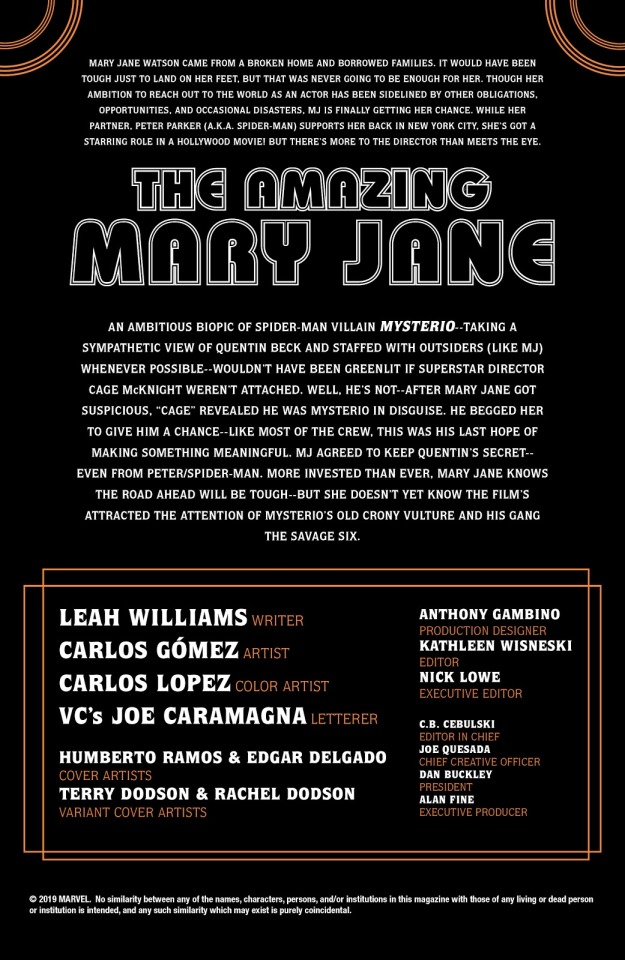
For starters check out this line:
....and staffed with outsiders (like MJ) whenever possible...
This is incredibly odd as it seemingly contradicts what issue #1 established.
I say seemingly because it depends upon how you define ‘outsiders’. Outside of what exactly?
The Hollywood system?
Traditional film or TV circles?
By those metrics the inclusion of so many criminals and former felons could fit the bill.
However, the recap lists Mary Jane as an example of such ‘outsiders’, which muddies the waters.
I suppose from a certain point of view she might be called an outsider but in context it doesn’t seem an appropriate descriptor at all.
Mary Jane has acting credits. She’s worked on Hollywood films before. She’s worked in TV before. She’s worked on stage before.
Alright, she’s not exactly Scarlett Johansson, but she’s not really an outsider.
More poignantly, the recap seems to be implying that MJ was included specifically because of her alleged outsider status. Putting aside how MJ isn’t really an outsider, this just doesn’t add up.
As detailed in parts 5-6, we the audience know that MJ’s inclusion is either due to:
Mysterio knowing about her connection to Spidey or
Kindred ordered Beck to include her.
The latter is the more likely answer. But even if it wasn’t the implication here is that Mysterio always wanted Mary Jane in his movie.
This is imbecilic of him because he is aware of her connection to Spider-Man!
Beck could be viewed as an obsessive and an egomaniac, but he’s not an idiot. If anything he is dangerously cunning. If he really just wanted an outsider actress with talent he’d have endless options other than Mary Jane to pick from.
Regardless of your feelings on the matter, the reality within Hollywood is that actors are a dime a dozen.
If Beck knows who Spidey is and therefore knows about MJ’s connection to him, he must have a specific reason for hiring her. He must have a particular need to keep her on set as he practically begged her to do in issue #1; a fact acknowledged in the recap itself. In fact in ASM v5 #25 Beck personally sought out Mary Jane’s former agent in order to get her into the movie. He didn’t look at a pool of actors and cast someone. He was incredibly specific.
Based upon the information we’ve been given, MJ’s connection to Spidey is the only explanation for all this. So what the Hell is this nonsense about her being an outsider? If he wanted an outsider why did he personally seek out Mary Jane?
I’m sorry, I can’t give the benefit of the doubt on this front. This is a clear cut example of incompetence. Either Williams and/or her editors weren’t paying attention to prior stories (including the first issue!) or they were and didn’t care.
Regardless it’s bad.
Moving on, we then have Cage McKnight referred to as a “superstar director”.
Wasn’t Cage supposed to be an indie director? Call me nuts but a ‘superstar director’ is surely someone like Spielberg or Ryan Coogler. An indie director is by definition not a superstar. It also further contradicts ASM v5 #29’s claims about McKnight harder to reconcile. In that issue McKnight was supposed to be a new and fairly unknown director.
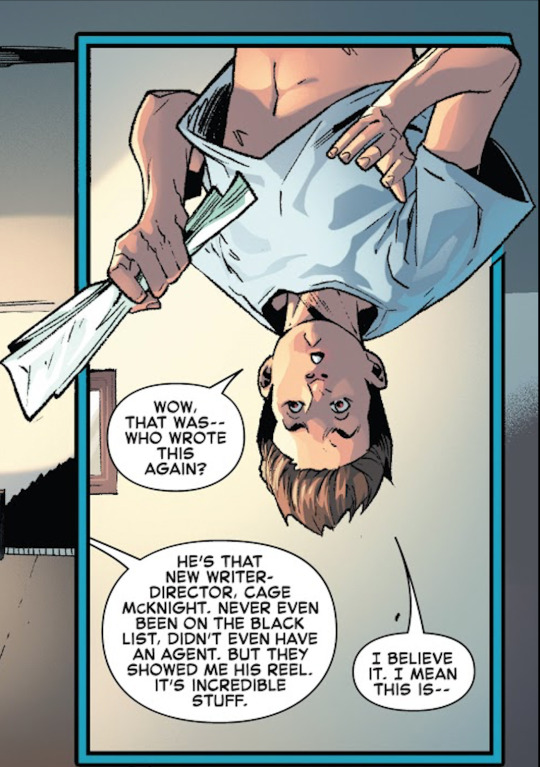

But I’ll let all that pass because he could be a super star on the indie scene.
Additionally, the recap in general fails to acknowledge the presence of criminals on set. They are simply referred to as outsiders and people who were on their ‘last hope of making something meaningful’. This totally obscures the reality of the situation and paints it as a lot less dangerous or irresponsible.
We then come to the most damning line in the entire recap.
MJ agreed to keep Quentin’s secret—even from Peter/Spider-Man.
That literally never happened in issue #1.
There was never a moment MJ agreed to keep Mysterio’s secret from Peter. Sure, we never saw her tell him the truth. But the story never highlighted the fact she was knowingly withholding information from him. She was incredibly casual about the film project and showed no signs of apprehension about lying to her partner.
It’s not even that Williams was being incredibly subtle. The first issue simply failed to ever acknowledge the fact that MJ was lying to Peter; she just did it!
More significantly the implication is that MJ is keeping this secret from Peter specifically because she’s sympathetic to Mysterio and his crew’s desire to make something meaningful. So I guess Williams is maintaining the mischaracterization from last issue huh? See prior instalments for why lying to Peter, sympathising with Beck and trusting him is OOC for Mary Jane.
Honestly, how would Matt Murdock feel about MJ letting Mysterio tell his magnum opus before he dies? The last time he was dying and decided he needed a magnum opus his girlfriend died!
Surely Karen or Gwyneth or any of the other innocent people Beck killed wanted the chance to do something meaningful with their lives too?
Why should Beck be afforded such an opportunity when he denied similar chances to people far more deserving?
Now granted this is just the recap page but the importance of a recap page is not to be underestimated.
Every comic is someone’s first, Stan Lee himself said that.
Recap pages are important as they give new readers the opportunity to jump on ship and thereby hopefully buoy up the sales as they naturally decline from issue #1 onwards.
Speaking from experience here, growing up my UK Marvel reprints had fairly detailed recap pages that provided enough context for me to pick up basically any issue and generally understand what was going on.
Having the recap contradict the actual story is misinforming and can thereby create a false impression of the work. Screwing it up is also just a bad sign for the rest of the comic. That’s particularly true when it’s providing details that weren’t actually present in the stories it is recapping.
Anyway, as we get into the story proper, we see MJ performing a scene from the movie.

I am not exactly sure if Williams is trying to make some commentary on Mary Jane here.
The dialogue her character says could be interpreted as commenting upon MJ’s growth as a character, on how she grew more capable of defending herself. Of how as she grew older she realised the real dangers in life were human beings not childish imaginings of monsters.
The main reason I suspect this might’ve been meant as commentary is that the dialogue specifically pints out how people wear masks to hide their true natures.
Masks are a recurrent theme in the Spider-Man mythos and particularly prevalent with MJ’s character.
If this was Williams intent it demonstrates a certain understanding of Spider-lore and of MJ that’s been woefully been lacking for most of the 2010s.
And one could justifiable argue the dialogue about how she grew stronger and more capable of defending herself is supported by her evolution over time. MJ never underwent a clear cut arc where she became more capable of defending herself. She was basically just shown to have bravery, common sense and resourcefulness. The frequent dangerous encounters she endured afforded her chances to put those skills into practice thus she got better at it, but she didn’t undergo active training towards that end like Batman.
Furthermore the dialogue can be argued to be talking about Mysterio as well, specifically the lines about monsters hiding behind pleasant masks. This is applicable to Mysterio’s masquerade as Cage McKnight.
However the comparison (if intentional at all) breaks down in two key areas.
The dialogue implies ‘Mary Jane’ learned that humans are the real monsters in life as she grew older. This is patently not true as MJ’s father was frequently abusive even when MJ was a baby.
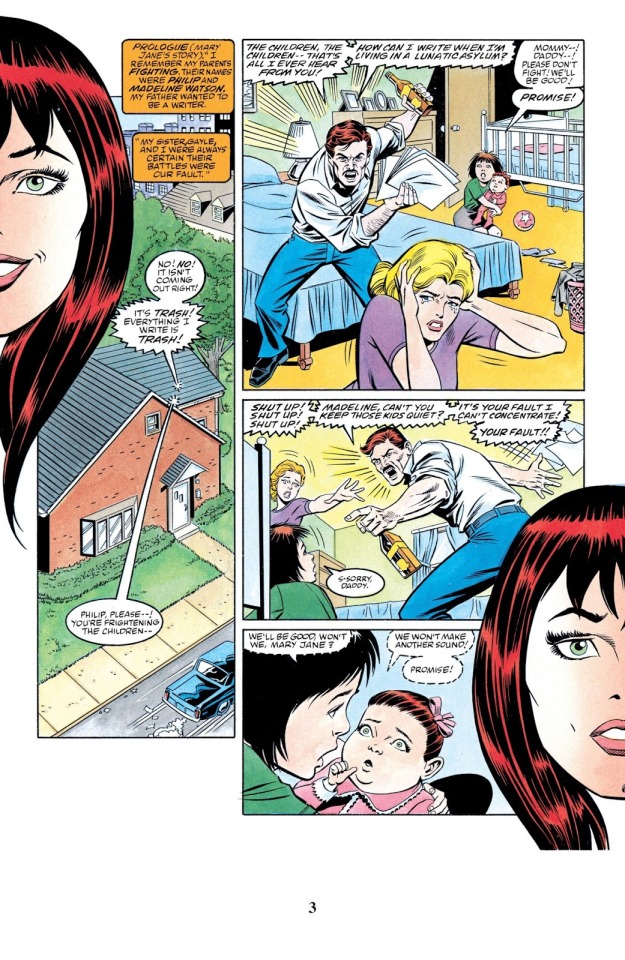
This was the norm for Mary Jane’s entire childhood and she herself created a mask of her own to cope with it.
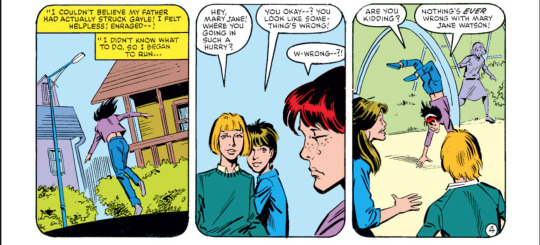
ASM #259
It was even implied MJ suspected Peter of being a ‘monster’ like her father precisely because she knew he hid the truth of himself.

So MJ would’ve been acutely aware that people can be monsters and use masks to hide this fact.
The second way the comparison breaks down regards Mysterio. If we accept that the dialogue is commentating upon Mysterio then it’s Williams acknowledging that Mysterio is a monster in disguise. This in turn throws her characterization of MJ into question. It implies Williams is knowingly writing Mary Jane as an idiot and out of character. It also doesn’t jive with his sympathetic portrayal in issue #1; nor in fact in this issue as we’ll see.
Of course all of that is hypothetical. I fully admit I might be reading more into this than was intended. Williams could’ve just thought this dialogue seemed cool and that was all.
I should also briefly discuss the artwork. In issue #1 I critiqued it because at times it made the intent ambiguous. In fairness that might be more down to Williams or the editors as opposed to Gomez. I suspect it will become a problem that will crop up moving forward. Nevertheless, it doesn’t detract for the utterly gorgeous aesthetic of his artwork.
With all that’s said let’s get back to the story.
MJ’s scene is interrupted when ‘Cage’ realises a pair of men are removing the wind machine. Actually, they’re removing several pieces of equipment the crew were renting. Mallorie, ‘Cage’s’ right-hand woman (sorry I don’t know Hollywood lingo), snatches a small piece of equipment and makes a point of withholding it from the men. MJ begins to ask what’s going on, turning on some of the charm for one of the men (named Noah).
‘Cage’ though is far less polite, demanding Noah’s attention. He warns him that, once Hollywood hears of this situation, he’ll struggle to find future work. Noah angrily retorts that ‘Cage’ hasn’t paid his rental fees in weeks, a fact confirmed when he checks his phone.
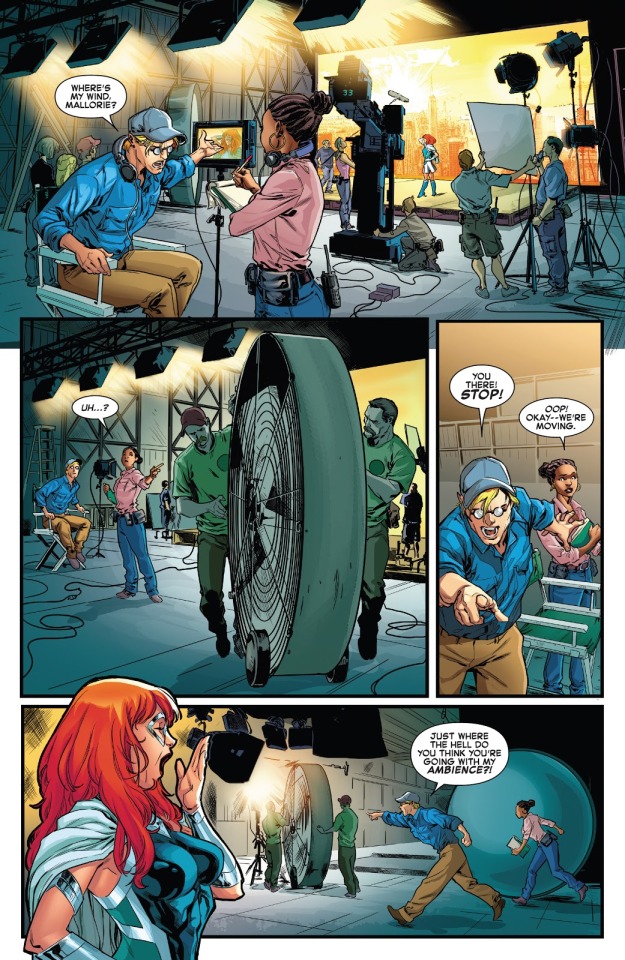
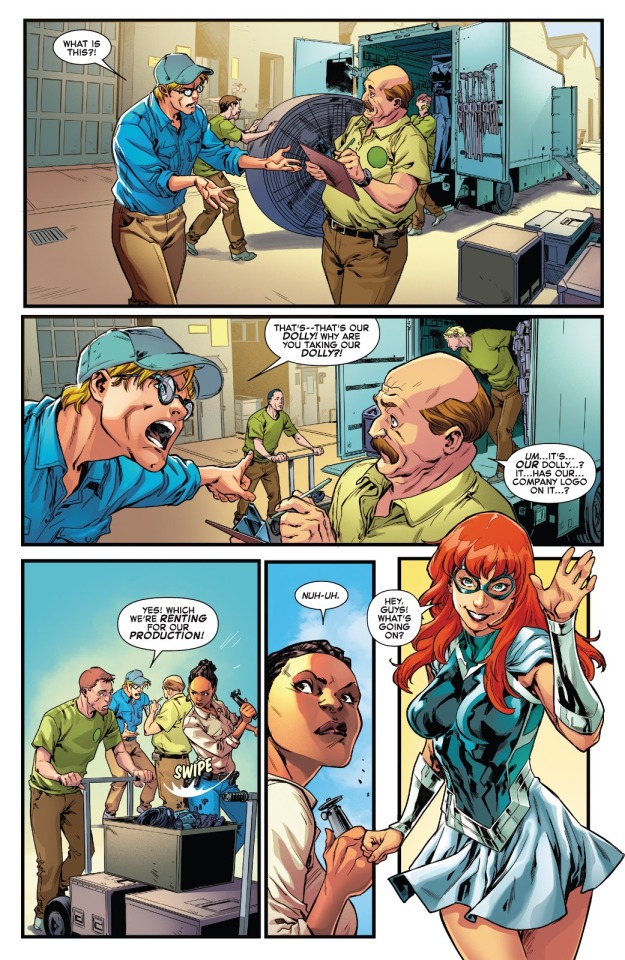

There are a few things to unpack from these pages, most of which further confirms topics we’ve already touched on.
For starters, we could argue Beck’s rudeness and threat exemplifies the danger he poses. Not just because he is a violent man, but also because he is seeking to ruin an innocent man’s business. This is something he could theoretically use McKnight’s reputation to achieve even more effectively.
Admittedly, that’s a little nit-picky.
Beck in Cage’s role here didn’t act unreasonably. He’s a bad person but even a good person could be forgiven or at least understood in this situation.
The real Cage McKnight may well be miffed at his equipment being removed and the lack of professionalism. That wouldn’t necessarily be grounds for Noah’s business to be harmed either if he was genuinely being unprofessional. Not to mention, we could easily give Beck the benefit of the doubt and say his threat was simply a bargaining tactic to get what he wants.
However, what’s less forgivable is Beck’s carelessness.
In the grand scheme of his history, failing to check his phone or pay some bills is hardly his worse crime. But it is endemic of a larger issue. Beck has never made a real movie before, not as the director anyway. The closest he’s ever come are his crimes, which granted would demand certain similar skills. However, he pulled off those crimes with little concern for any henchmen he involved nor any legal or financial obligations. He funded his crimes through other crimes. He viewed his helpers as disposable. And as for breaking the law, that obviously wasn’t going to bother him.
In this story Beck has dozens of people who’s jobs (and possibly their careers) ride on his decisions. The narrative has even painted him as genuinely wanting to help them. And yet he has failed as an incredibly basic responsibility. He hasn’t even considered delegated that task to someone else. It’s exemplary of selfishness at worst, and poor leadership at best.
I’m not trying to argue any of this is out of character for Mysterio. Rather, it’s the implications of this within the status quo that are concerning.
On to of everything else, Mary Jane has decided to go along with Beck’s passion project without considering if he’s even qualified for the job. Creative vision isn’t enough, you need basic competency as well. You need to know how and who to delegate stuff to if it’s not your forte or not what you are interested in.
It’s also further exemplifies the potential damage Beck can bring to the real McKnight’s reputation. If word of this gets out suddenly McKnight at best might be regarded as rude, at worst a poor leader and incompetent. Incompetent with money no less, which (above anything else) is likely to paint him poorly in the eyes of the Hollywood power players.
This misuse of Cage’s reputation continues into the next page where Beck outright throws McKnight’s name around. He claims there has been a mistake because his movie was given a generous budget. Mary Jane tries to calm the situation down and sits in one of the fold out chairs. Her plan is to prevent the men from removing it off the set, a scheme Mallorie (literally) adds some weight to.
In spite of ‘Cage’s’ borderline verbal abuse, Noah expresses respect for Cage and the film project, suggesting he talk to the money people.
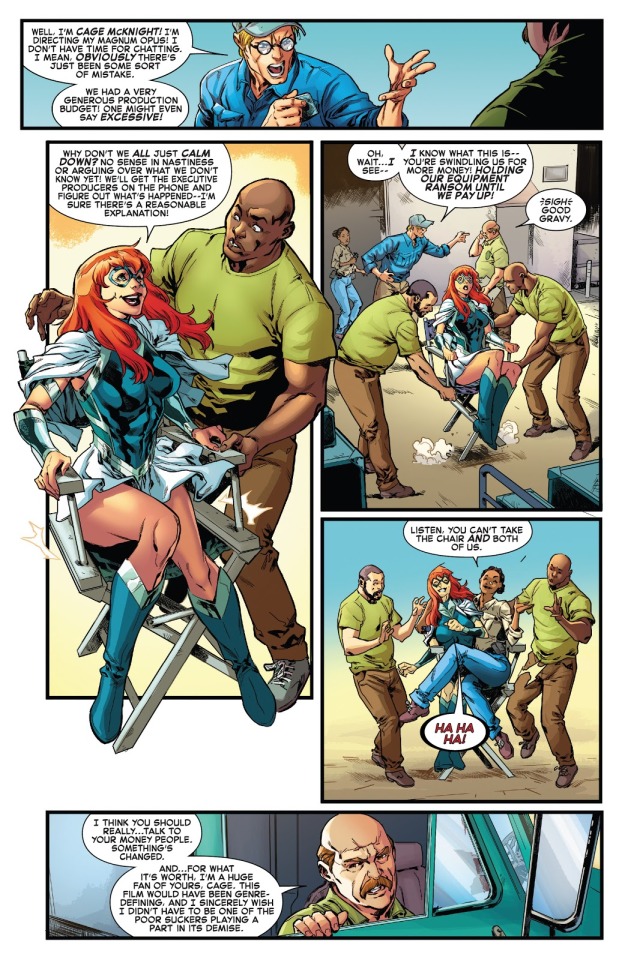
By rights MJ in observing this entire scene should be much more sceptical of Beck. At the very least she should wonder if she’s made the right decision in helping him. SPOILERS: She won’t.
What she does do though, is use her charm/social savvy to defuse situations and keep Mysterio under control. This is clearly part of the direction Williams wants to take the series in. In fact it’s the central conceit of this entire issue.
On this front Williams does a superb job. No seriously, I might hate this status quo. I might loathe the mischaracterization facilitating it. I might despise the contrivance that keeps it going. But it’s stuff like this where Williams once more displays a deftness with MJ’s character.
She understands that Mary Jane possesses superb social skills that can serve as a form of ‘super power’ within certain contexts. Williams has (clumsily) generated one such context and thus allowed MJ to shine. You could genuinely cite or post this scene to exemplify some of the strengths of Mary Jane’s character. If you want a Spider-Man comparison, it’s a little like citing Otto injuring Scorpion from ASM #700 as an example of Peter’s raw power. How we got to that moment was nonsensical but unto itself it is a great example of a singular aspect of the character.
Another example occurs when MJ prompts ‘Cage’ to seek out more money for the film.

This moment demonstrates MJ’s practicality and determination. It’s just a shame that display entails her helping a criminal and suggesting they con yet more people!
The next page is a montage of just that, with Hollywood money people turning them down. ‘Cage’ reacts by angrily flipping tables. In contrast MJ calmly and politely tries to inject some positivity into the meetings.
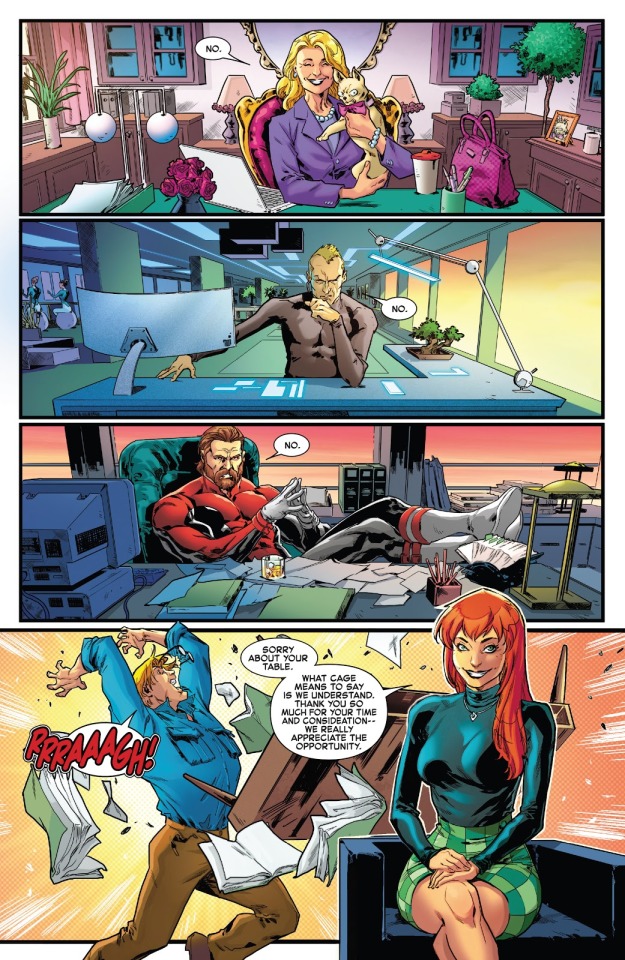
Williams again does a great job of showing MJ’s personality. She keeps in control and is a great people person. She is practical and knows how to help Mysterio get stuff done.
But take note of ‘Cage’s’ misbehaviour in front of the money people. This opens up the possibility of him being dangerous and unstable, therefore a liability if left unchecked. Were this an exception to the rule or extenuating circumstances, that’d perhaps be understandable. But Mysterio, whilst not exactly defined by his rage, is a violent person. He has inflicted physical and mental harm/abuse to people. And his bouts of bad behaviour are likely to negatively impact the real McKnight’s chances of working with any of these people in the future.
I’ll leave it there for now. We’ll pick up where we left off last time.
Previous Part
Next Part
Master Post
#Leah Williams#amazing mary jane#mjwatsonedit#mary jane watson#Mary Jane Watson Parker#MJ Watson#Mysterio#quentin beck#Spider-Man#Savage Six#Vulture#Peter Parker#Carlos Gomez
13 notes
·
View notes
Note
Same writing anon as before! Tysm for the long post, it was really clarifying and good to read. It's started having some stuff make sense and revealed some stuff I need to rework. Do you have any advice on writing bare-bones like, general plot lines?
Hey! I’m so glad to hear that. 💙
I’m not 100% sure what you mean—advice on making your plot lines engaging, on figuring them out period, on how and when to structure them, on how to make them original, how to make them further the scenes you want to write instead of just be there as a support column for them, etc, so sorry if I misinterpret this question. I think I’m probably overthinking this, and you just mean “advice on how to come up with them/lay them out in the first place,” so that’s what I’ll answer. Sorry if that isn’t what you meant. TuT
So, writers all have different processes, but for most of us, it is very much not plotline first. Often you’ll get a great vague idea, or a scene you don’t know the total context for, or a character you like, or a finale, or a specific crisis, etc, and start there. Similarly when writing fanfic, a lot of the time you start with a very basic concept like “I want to see these people interact” or “I want this character to get to kill the person who destroyed their life” or “I want C character to get a happy ending,” and you build from there.
Honestly, there isn’t just one way to do structuring that works. Some people like a bare bones outline before they start, some like hugely detailed outlines, and some get a vague concept for how it will end, and then just start writing. And they can all work! I will say though, if you’re writing something heavily solution-based (like your characters spend the whole story trying to escape a sinking ship in the middle of the ocean, or are trying to fix a time paradox to keep themselves from being erased), it’s highly, highly recommended you know what that solution is before you begin. I don’t know that you /can’t/ figure out on the fly, but it will be so much easier for you as a writer to work towards a solution you already have, than to fly blind. Especially because most solution-heavy plots pick up elements to their solution along the way. This isn’t always necessary—like if the problem is it’s a horror script and there is a serial killer chasing them. “How do you kill a human” has infinite answers, so you don’t really need to pick out specifically how your protag finally takes them out ahead of time if you don’t want. If it’s like, Nightmare on Elm Street though, and your monster almost can’t be killed, you really gonna want to know how to put it in the dirt before you start, though.
That said, I’d recommend doing at least a bare-bones outline, personally for anything very long! It’s totally good and recommended even to edit that outline as you go, to add or subtract or alter upcoming content, but I find it helps a lot to have a vague idea of how much is left, and what the next step will be. It’s kind of reassuring. Again though, not everyone does this. Some skip outlines altogether.
As far as plotting itself goes, I would say start, again, with what you want to write—this might seem counter-intuitive, but trust me. Do you want to write a friendship, or a romance, or a personal journey for a character that leaves them feeling whole? Okay, well, even though most of those don’t seem very plot-creating, consider two factors: what would make this thing you want to have happen happen? And why do you want to write this thing?
For example, I wrote a horror comedy feature script, and my initial idea for it was just a gimmick—the main character can hear the OST, and uses that to help her stay alive. Okay, well, what’s the plot to that? There isn’t one—yet. But why do I like horror comedy in general—why pick that genre? Because horror comedy tends to be a deconstruction/reflective of horror as a whole, and a lot of those commentaries are very meaningful to me. Okay, well, what about horror am /I/ interested in reflecting on? And there’s a lot I’m interested in reflecting on, tbh, but at the time, the big answer for me was casual dehumanization. So, I know my topic/theme, and I know I am picking a wild world for that (as in, I want to write about not dehumanizing people, but I’m setting it in a world where the MC can literally hear the soundtrack to her story), but that can help, honestly, because if you can carry your point with a disadvantage, that’s even better. So I know my gimmick, I know my core issue, and I know my main character. Now, if I want to talk about dehumanization, that means it’s got to be what my killer is doing, and to an even more extreme extent than murder in general, so they must know the victims personally. From there, I worked out who would be best to cast as antagonist and a motive for them (considering other people not as significant as them/ethics are just created by humans mentality, justifying murdering even friends in order to gain serial killer immortality fame), and went from there to okay, so how would they (the killer) do this? And there’s a lot of ways to approach that scene detail plotting. Usually, I just kind of daydream. I make a cast first, then try to figure out what scenes would work well, and once I have a couple in line with my whole plot, string together an outline that supports all of them, and from there carve out a solid start to finish storyline—like, uh, like whittling down a carving, or chipping away to make a statue, kind of. Think of the starting process as a little like solving a mystery by taking clues and working through them to the next logical deduction, I guess, haha.
You can start from a bunch of different places though, not just concept/theme. For ILM, my original thought was just, “I want the survivors to get to escape, but HOW could they do it?” And I tried to solve that problem. Once I had a solution, which was genuinely one of the first things I found, I was like, okay, but it shouldn’t just be about that, because that’s got no real meat—it’s just an ending. What else do I want to see in a story about them? And Wraith was my favorite killer by far, so I thought, “I want to see Philip get to redeem himself and befriend the survivors and be kind and happy,” and that was it. From there, I worked out first where I wanted Philip at as a person/his motivation for how he ended up where he was, which plus some research created the resets for him, and then I worked out how it would start for him, if he was going to befriend survivors. I picked out relationships I wanted to see furthered, and decided if I wanted them to get a happy ending in hell and give Wraith redemption and peace, that meant I was writing a hope punk plotline for sure, and then with a basic idea of how I got from A-Z, started writing. A lot of individual plot lines—Laurie, Quentin, Jeff and Legion, Tapp, Anna, etc, I had not worked out before I began—maybe I had a kind of vague idea what I wanted for them (Laurie to regain her will to live and be able to save her brother too/get him to save herself, Quentin to get closure, Anna to find humanity, etc), but mostly I kind of brainstormed each the character arcs when I hit their first POV chapter, and crafted their personal story arcs there, then adjusted some as ideas grew.
Which was a super different process form my feature. While my feature more or less hit “what’s the theme/core concept” right off the bat in planning, ILM was “What’s the goal” and didn’t hit theme really until partway through writing, so the process won’t even always be the same for you as a writer. But I definitely recommend, no matter what you’re starting with, to go about it by looking at what makes you want to write what you are writing. For New Dawn Fades, my initial starting point was literally just wanting to write a scene between Quentin and Joey—that was it. I had no framework, or theme, or story goal—just a scene. But I was like, okay, well, if you need a story to back this once scene and further it, not just give it an excuse to happen, what is the story? Well, the reason I wanted to write the scene was because I liked how Joey and Quentin interacted. Quentin’s a bit of a martyr and constantly overwhelmed with guilt and trauma and had to grow up way too fast, and Joey’s a decent person at heart that has let himself slip way too much into bad territory out of fear, and together, they kind of bring out the best in or for each other; Joey is like, the single most likely character in DbD to be able to remind Quentin he’s legit just a teenager actually and should cut lose and just be okay for at least like fifteen damn minutes a day, and might actually be able to get him to do it, and Quentin’s the right mix of uncompromisingly ethical and genuinely forgiving to get Joey to look at and reevaluate his choices without spiraling into hopelessness and self-hate instead of self-improvement. So the answer was I wanted them to get to help each other. From that starting place, I just kind of went step by step with “Okay, how could they logically meet in such a way they are forced to spend time together and it gives them a chance to reach some of this,” and the rest came pretty easy. A lot comes step by step too, I find, and sometimes I have a whole super solid outline before writing and sometimes I don’t know beyond the next chapter except in the most general of terms. So what I would basically always recommend with making a general plotline is consider why you want to write what you want to write, and move from there to, “Okay well how do I get it.” And that process will be wildly different from story to story, but as a basic start, it helps me a lot. I wanted to see Claudette reach out to Wraith? Okay, why would she do that, and how? How would he react—what are the consequences, both from other people, each other, and the Entity? I guess I kind of go at plotlines like a puzzle. If this happens, what are the characters’ next choices? Which would they pick? And if I know where I want them to end, how do I steer their situation towards that point? For doing this, I highly recommend listening to music and daydreaming/just watching and trying scenes out some in your head. Also, if you get stuck, watch or read similar stories and let that inspire you! I don’t mean you gotta or should like, trace over someone else’s scene or something, but all fiction is intertextual, and that’s a good thing. We write based on our existing knowledge and love or ambivalence or distaste for other stories, and in communication with them, and it can add a lot. Stuff with Laurie & Michael in ILM didn’t end up like a single Halloween film in any of the six+ damn timelines, but I /did/ draw inspiration from the H20 line, and H2, which were the closest those two ever got. Watched the end of H20 and went, okay, if they’d had a better chance sooner, what could have happened, and played with that. Watching a lot of well-made fight scenes is also great inspiration for writing action—highly recommend.
I’m not entirely sure how helpful all of this will be, because plotting techniques tend to be pretty varied from writer to writer, but I hope it helps. If it hasn’t, here’s a quick compilation of more technical-side based tips that hopefully wil:
One technique I see recommended a lot and that can help/has before, is to start with your core concept. Now, I would disagree that you must always start here, but it can be a very good place. The idea is to be able to sum up in one line what the meaning of the story is. Like, for the film Holes, it would be something like, “Evil in this world is caused by treating people inhumanly, and the only way to break that curse is to treat your fellow man with decency and value and love.” Basically every plotline in the film backs this idea—Kissing Kate, who is a kind and happy woman until the man she loves, Sam, is murdered by her town for being a black man in a relationship with her, a white woman. That inhuman act drives her to become an outlaw. You have the Yelnats, who get cursed to be followed by misfortune forever when Stanley doesn’t honor his promise to Madame Zaroni, none of which would have happened if he had listened to her in the first place & not gone after a girl based solely on her looks, or if she had cared who either suitor was as a person, and could have been avoided had Madame Zaroni been more to Stanley than a means to an end. You have a whole cast of delinquent boys being mistreated and not at all healed by a juvie system that treats them all like they’re no longer humans worth anything. You have Zero, not even treated as human by juvie standards because he doesn’t talk, isolating himself—all of which stems from growing up on the streets impoverished with a mom struggling to do her best and failing. Stanley is falsely convicted for a crime he didn’t commit and mistreated over it, and has his life ruined. Even Grace, the main antagonist, is who she is because her family has been obsessed and abusive for generations, and she grew up a tool to her father. Then in the end, almost every one of these wrongs, even the ancient wrong of Sam’s murder, is corrected by people choosing to be better and break—in two cases quite literally—the curses on them and others by just being kind and choosing to love and treat others with respect and care. Stanley chooses to befriend Zero to be nice, and Zero reciprocates. Then when Zero runs off, Stanley runs off to help him because he’s afraid he will die, and simply because he loves him as a person, fulfills his family’s ancient promise unknowingly by carrying Zero up a mountain in search of water to save his life. This gives his family and him luck again, and ends up saving everyone. Zero tells Stanley the truth about himself and stops self isolating and being just sad and alone because he had a friend who treats him with value, all the boys end up okay and semi adopted by Stanley’s family in the end and out of abuse and juvie and treated well and live up to that faith put in them, and justice being finally brought breaks Kate’s curse and lets it rain again for the first time since Sam’s death and gives Kate’s spirit peace. —and that’s the idea. To have all your arcs and themes back your one core concept. Now, sometimes people find this super helpful, sometimes they find it overwhelming, but it can be worth a lot.
Another is to just kind of try the dartboard model, which is getting an idea you like to start with (like uhhh, Dogfighting dog is injured so it is going to be put down, but it escapes it’s master and runs off into the woods. Out there, it wanders until happening on an injured human child). Okay, so the plot is about a dog that has been abused choosing to connect to a human in spite of that, and probably about how the kid survives getting out of the woods with the dog’s help. But what actually happens? Dartboard method is just come up with a bunch of potential scenarios for the two characters and play them out in your head, keep your favorites, and then see if you can find a way to string those scenes together. You like a scene where the dog fights off a mountain lion, a scene where the kid and dog huddle together for warmth in a cave during a storm and the kid gets to be the one doing the looking out because the dog is terrified of thunder, and you like a scene where the kid is walking with a branch to help them keep going, sees a road up ahead which means help finally, but passes out from exhaustion, so the panicked dog has to deal with intentionally attracting the attention of adult humans after the abuse it has suffered, in the hope it can lead them to the kid and get help? Great. Okay, what basic order do these scenes go in, what can fill the gaps between X and Z? A lot of thing, you’ll have fun scenes you end up having to reject, because they don’t fit, but it’s a pretty laid back if chaotic method.
Then of course there’s just the classic. Outline. As in, take whatever idea you have, and force yourself to pitch a complete A-Z set of steps like you’re in a writing class. IE:
Dog is introduced. — Dog is inured and going to be put down. —Owner is distracted by a fight breaking out, and dog manages to jerk leash free and escape. — dog flees to woods. — Dog is alone and skittish. There is a storm and it freaks out and holes up. — Next morning, after the storm, Dog hears human crying & is afraid, but curious. Goes to peek. Sees kid who has must have been out here in the storm because a branch snapped and has pinned them by the leg — Dog wants to help because dog instincts, but is afraid of even small human. Eventually peeks head out. — Kid is terrified too, because scary huge scarred dog and they can’t run. Dog scared because human. — Eventually, kid gets over fear and tries to call to dog, and it comes out. Kid pets it and it’s afraid to be touched, but then accepts the affection. — Dog tries to help kid out by digging their leg free. Kid, who hand not thought of that, helps, and gets free.
(Usually you do this more branching and pretty, IE: Scene 1: Dog is in a dogfighting match.
—1A: Dog loses fight and suffers a bad infury to its eye, making it no longer fight for fights.
—1B: Dog’s master angrily comes to collect them. Dog tries to get affection, but he’s mad at it for failing & mutters about putting it down.
Scene 2: Owner takes dog out back to put down.
But that would take up a ton of space on this already massively long post.). There’s also a more simplified version of this, where you just kind of go like Chapter 1: Dog is introduced, loses fight, then escapes being put down and flees. Chapter 2: Dog is terrified of a thunderstorm and from having been almost killed & forced to fight for so long. Runs out of town to the woods as the storm breaks. Hides out under bush. Chapter 3: Dog wakes up to hear human crying. Goes to investigate hesitantly. Finds human kid trapped unde fallen branch. Kid is afraid of dog, dog afraid of kid, but eventually kid coaxes dog to come over and befriends it. Dog tries to help kid and dig them out, and together they get the kid free from tree.
As you can see, that basically gets the same information across, it’s just much shorter, but also has less solidly set as far as details of how stuff happens. Again though, if you go for an outline method, please don’t feel like you have to be married to it. It’s just a resource to try to help you, not actually the story itself, and stoeiws pretty much always evolve as you go, so it’s normal and also kinda fun and good to have to adjust outlines.
Anyway, this was already a mouthful, but I hope it helps, or at least some of it does! For me personally, the best techniques have always been to daydream scenes and events, and to approach writing things I get stuck on either like a deductive puzzle of “Well if She does This, then her friend can do either X, Y, or Z, and Z makes the most sense. Now, I need to figure out a way for them to escape the building. What are th options? Window, door, roof? Technically they could bust down a wall. They’ll never make the roof in time, so that’s out. They have about two minutes before dying, and one of them is injured, so they can’t go fast. The arsonist is going to be watching the front door and the windows carefully though, just in case, so they need a diversion or—Wait—the cat door in the garage. Perfect.” —or by trying to get very into the headspace of whoever is running the scene, and just literally think through why they want and are feeling and going to do. (Though again, I personally approach writing from a very acting-heavy standpoint). Anyway! Hope this helps some, and you find what works best for you. If you want clarity on any of this ramble, or I misinterpreted the questions feel free to let me know! TuT 💙
#ask#anonymous#writing#writing advice#long post#sorry this is such a lengthy hulking thing—theres jsut SO many ways to do plotting it takes a long time to list and describe even a handful#TuT#hope it helps though
3 notes
·
View notes
Text
Batman TAS: Fear of Victory
“He’s locked up in Arkham…isn’t he?”

Episode: 24 Robin: Yes Writer: Samuel Warren Joseph Director: Dick Sebast Animator: TMS Airdate: September 29, 1992 Grade: B
Hey! Robin is back! About time, huh? This is the first time that we have seen him since episode two, but the show explains this by showing him living in his college dorm. And it makes sense that, with his roommate being directly affected by the Scarecrow, he would get involved, working with Batman, even if he is not on any vacations or anything. I asked Char what she thought about seeing Robin again, since she is a DCAU-virgin, remember. Her response was honestly not what I expected, but it was nice to hear! I figured she would be really surprised that he was absent for so long, but she did not think all that much of i. I did tell her he was generally away at college after we watched Christmas With the Joker, so I suppose that’s what she was expecting early on. It was a nice treat to have him back, she said, but she seems to like the flow of Robin that we have gotten so far. And so do I. They were very smart about how they handled it. The show is stylistically best when it is just Batman for most of the time, but Robin is also a nice character, so seeing him occasionally is okay with me. He could have been overdone very easily, though. Like, if we got the Joker every episode, even though we love the Joker, that would get old. Same with Robin, noting his more happy-go-lucky/smartass personality. He is the type where it is wise to wait for an episode that needs him instead of attempting to work him into an episode. And while even though Robin worked fine this time, did they truly accomplish this task? Did this episode need Robin to work, or would it have worked better without him? There is a difference between being okay with Robin because we like him and we haven’t seen him in a while vs being okay with Robin because he actually adds something meaningful to the episode. Personally, I think that this episode falls into the trap of making Batman slightly less competent so that Robin seems more needed, while also making Robin the “damsel in distress”.
With Batman’s competence (or lack there of), I am referring to the end battle up high above the football field. The part where Scarecrow threatens to drop a vile of his fear powder onto the audience below, resulting in utter chaos, and at least a handful of injuries. After all, people in crowds are fucking crazy as it is. Just look at Black Friday. Now add some Scarecrow chemicals, and you have a messy situation. But what happens is that Batman seems to have an awfully hard time preventing Scarecrow from dropping the vial, despite Scarecrow really not providing any type of physical threat to Batman. They both fumble around on the catwalk, and I get that it is a small space, but I feel as though Batman could have done something to prevent one or two of the vial scares. And that box of lightbulbs up there is a little bit contrived too. It seems a little bit dangerous that anyone who works there would keep a box of lightbulbs above a football field, it could fall off and hurt somebody. And well, here it does hurt somebody! Batman was not even ready for it. The same guy who can quite often predict when someone is right about to jump him from behind. All this is to allow Robin the chance to save the day, catching the vial in midair. Which is fun, I like how his actions aligned with the football announcer’s commentary and all. Yeah, this segment was still enjoyable to me, don’t get the wrong idea…it just helps not to think about some of the silliness too hard. At least, as an adult. I think what could have been much more interesting is if Batman ended up absorbing some of this fear powder. Maybe Scarecrow could have ended up smashing the vial in his face or something. Then Robin could have had a much better chance at being the hero, without making Batman look like a putz. Batman has been affected by Scarecrow’s toxins before, and the imagery that he gets is incredibly powerful. What if he saw his parents, but then it was his own adopted son that snapped him out of it and kicked Scarecrow to unconsciousness, facing both of their fears and ending the problem.
And also, as I said, Robin kind of portrayed the damsel-in-distress. I’m referring to the scene where he first becomes affected by the toxin, and nearly falls off of a building from high above the ground. I think if Robin did something a little bit more meaningful at the end of the ep, like the idea that I had, this would work better and seem a little bit less flimsy. But this is only Robin’s second DCAU appearance, and already he is screwing things up like the ol’ trope goes. Again, though, this scene was perfectly enjoyable, and if Robin was not already jokingly known for this by comic book fans, I likely wouldn’t even mention it, but in the grand context of the character, I couldn't help but roll my eyes a little bit. As positives, his voice actor, Loren Lester, did a great job of the emoting, and it is hard not to feel scared for Robin. This scene also highlights the danger of what Batman and Robin partake in every time they don their costumes. Even something as simple as using their grappling hook to go from building-to-building is not recommended for your everyday, average Joe. One little mis-step and you can fall to your death. So in a way, Robin experiencing this adrenaline rush is bringing Robin down to our level, and lifting the veil for him, reminding him of what exactly he’s doing with his life. And he is not like Batman, where he needs to be a crimefighter to feel that fulfillment, to clear himself of guilt. So if Batman were to be affected by this particular fear-powder, I don’t think that Batman would gain that fear of heights that Robin did. I think that his visions would be much different. Batman simply does not share the same reality that Robin does. They are truly very different people, and the more I think about it, the more I am not surprised with what happens later on down the road with these two, but I will not give any hints to avoid spoilers. Let’s just say that once Robin grows up, there is an unavoidable relationship change just waiting to happen.
Scarecrow got a redesign in this episode, looking quite a bit different from when we last saw him in Nothing to Fear. Char ad I both much prefer the new version, but she noted to me that the straw hair is a little bit much. Yeah, I can see how that would bring the intimidation levels down a bit, but the face and body look so much better (partially because of TMS’ awesome animation) that it doesn’t bother me. I was surprised to see such great animation with this episode, honestly. Maybe it was because the last Scarecrow episode didn’t turn out looking that great (despite the debatably better story elements that it had), and they wanted to make sure that they could make Scarecrow seem like a more intimidating villain than he did prior. The show has also come a long way since then, and even though I’d call this episode a more mid-tier one, episodes like Nothing to Fear were once the standard! Seeing the new Scarecrow design can kind of represent that evolution, and it’s like we’re starting fresh now that Batman the Animated Series has most certainly found its footing. It’s as if they meant to say, “Here’s how we actually envisioned Scarecrow, guys, now that we are running a show that has the potential to display it!” If they redid Nothing to Fear this far into the show, I have zero doubts that it would have been way better than Fear of Victory. But we’ll have other opportunities for great Scarecrow episodes soon enough… For now, here, as usual, are some screenshots!

I love how in keeping with the show’s aesthetic, the player’s get old-style Football uniforms/padding. Great detail!

Take a look at that funky remote-control.

Robin’s first scene since Christmas With the Joker!

Awesome foreshadowing here, putting that heavy shadow onto Brian’s face, telling us subtly that something bad is coming.
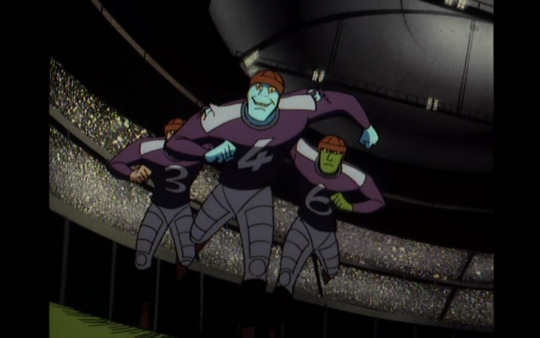
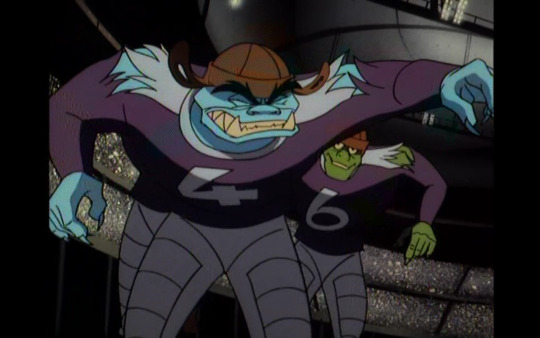




Coupled with the roar that they give, this was way scarier than anything from the first Scarecrow episode. Great work by TMS!

Does Scarecrow really need to change into his costume just to watch the game from above? I guess he is an Arkham patient, though.

“Oh no! Not him!” Referring to Batman. Way to acknowledge Robin, guys.

Robin the height like many of us would if we ever tried this!
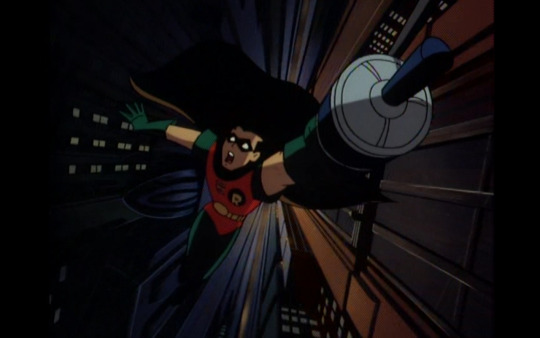
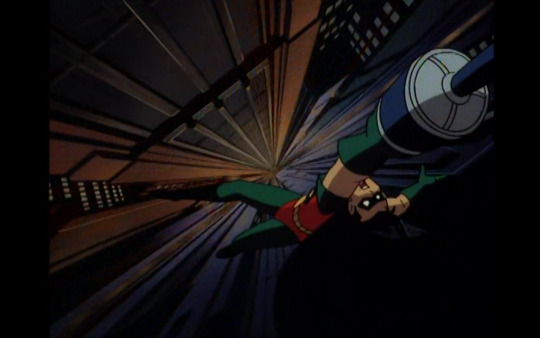
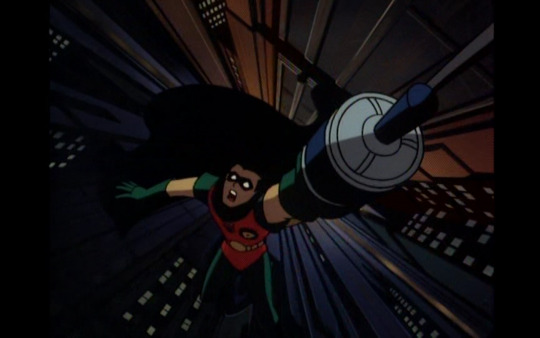
Another gorgeous movement, capturing the dizzying heights.
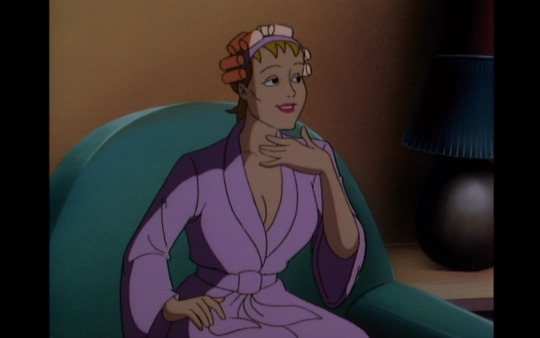
“Oh my...” Too bad Batman has work to do.

But that doesn’t mean Batman can’t give her a little smile as he leaves her apartment...

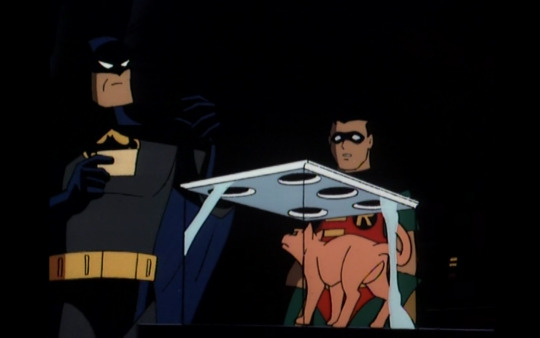
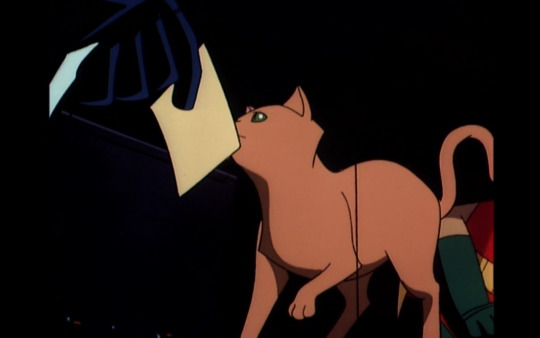
So where did Batman exactly get all these cats? Could they be Selena’s, and he’s looking after them? If so, I doubt she’s appreciate you testing some possibly harmful chemicals on them! This didn’t seem very Batman-like to me.

“Hey! Corn on the cob! A scarecrow’s gotta love that!”

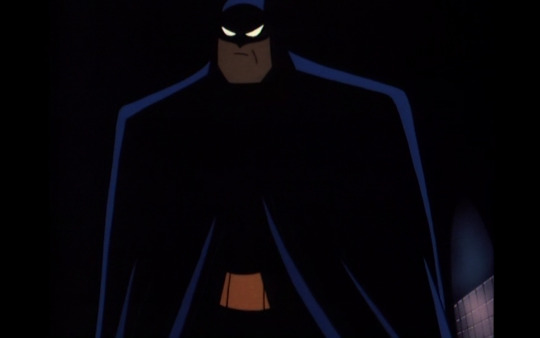
Batman fades into visibility as he walks through Arkham Asylum. And in here we get to see...
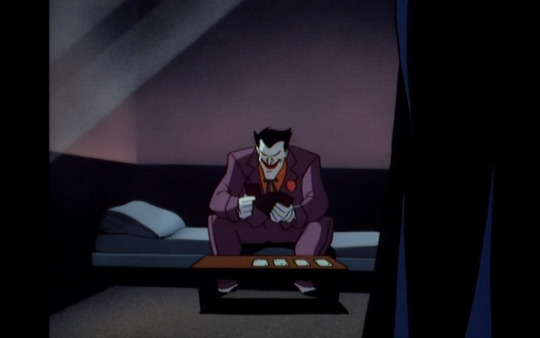
Joker...

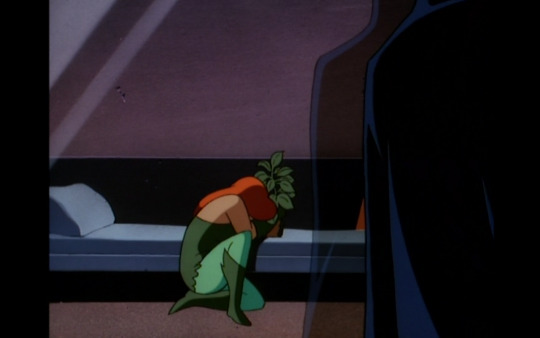
Ivy...

And Harvey! Oh. Harvey. This is the first time we’ve seen him since the end of Two-Face, showing us that he indeed ending up at the asylum. Poor guy.

But of course, Scarecrow is gone. The corrupt guard, who obviously helped Scarecrow out (maybe by bribe?) shows how some of these baddies always seem to escape.
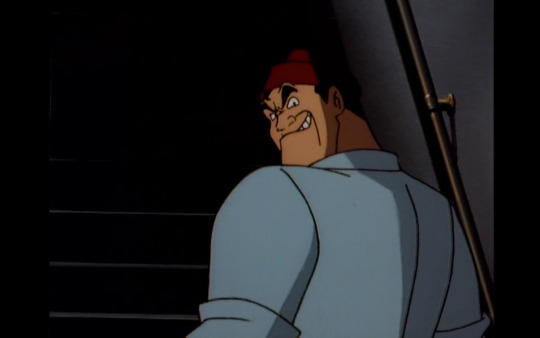
“Be persuasive.” he knows what that means.

Once we see the powder coming off the envelope, we know what’s coming. A nice moment of anticipation.
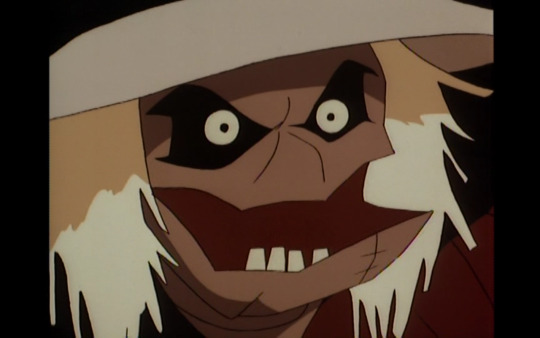
Such a better design!

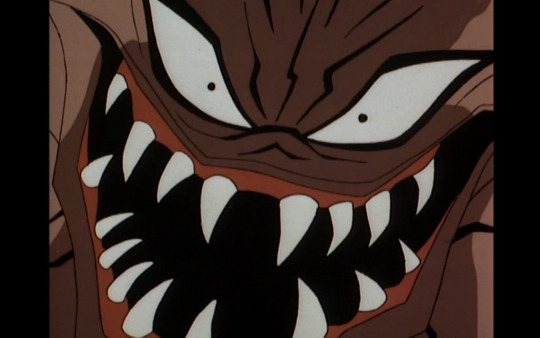
That’s the look of a man who just shit his pants.

Not your wisest idea, Robin.

“I’ll drive real slow.” I was half-expecting him to then blast out of there as top speed, hahahaha.

Again, Scarecrow, why do you need to be in full costume right now? You’re going to give yourself away! What if someone happened to walk by? Or, I don’t know, be hiding in the jerseys..?

That “R” on his shirt here is huge.


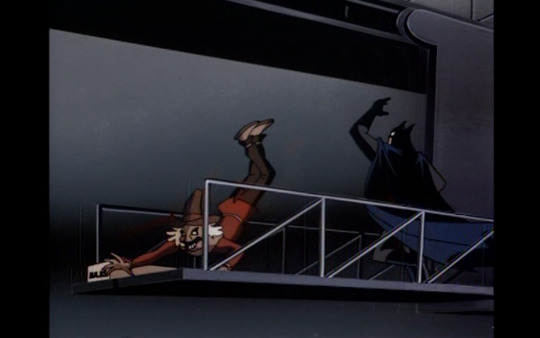
I love the way that Batman throws him across the catwalk. Also, I feel like his costume was inspired by Freddy Krueger.
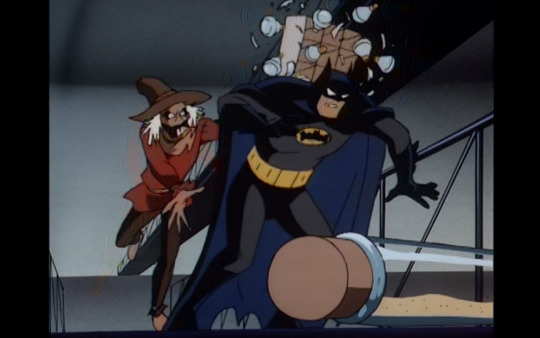
This is why we don’t leave lightbulbs around.
Char’s grade: B
Next time: The Clock King Full episode list here!
#batman tas#fear of victory#dcau#dc animated universe#scarecrow#btas#batman the animated series#robin
2 notes
·
View notes
Text
Punching Up: The Last Jedi

Let me make one thing clear right off the bat: The Last Jedi is a great Star Wars movie. Folks are certainly permitted their own opinions on that, but anyone saying it’s a bad movie on the level of the prequels or “the worst Star Wars movie ever” is really quite silly.
However.
Part of the reason I love TLJ so much is that Rian Johnson really swings for the fences. He had big ambitions about what he wanted from a Star Wars movie, and he bloody well went for them, seemingly without much in the way of review by committee, at least not on the scale we’re accustomed to seeing from big studio blockbusters. This was great in terms of allowing the film to make bold decisions, but I believer it also contributed to how uneven the script turned out to be.
See, I love The Last Jedi because I can observe its ambitions (daring character choices, themes of failure and humility, feminist and anti-capitalist politics) and embrace its triumphs (beautiful cinematography, brilliant performances, meaningful stakes, a truly compelling A-plot with Rey, Luke, and Kylo). The pros outweigh the cons, and there are more pros in TLJ than in any Star Wars project since The Clone Wars and any Star Wars film since the last with “Jedi” in the title. That said, the sheer size of the movie’s reach (and runtime) left room for more obvious faults than any so far in the Disney era.
The movie’s pacing is all off. The plot meanders. Conflicts and relationships are muddled and sometimes confusing. The tone shifts around from fun romp to deathly serious, sometimes in the middle of scenes. The script needed at least one more pass. It needed a punch up.
So, in what might be the only installment of this series I do, I’ll be taking a look at the movie we got and, with the benefit of hindsight and fresh eyes, relate three major script notes that I would’ve passed along to Rian before shooting began had I been asked for some reason. To the best of my ability, these suggestions for changes do not lengthen the runtime or raise costs. Most importantly, they keep all of Rian’s ideas for settings, characters, and themes intact. They are:
1. Reduce, relocate, and reframe the Canto Bight sequence.
2. Make explicit Holdo’s suspicion of a spy on the Raddus.
3. Thematically connect the A and B plots by connecting Rose to the Force.
A lot of these feel pretty obvious and have probably been suggested by others before me, but I’m just gonna just assume that something I thought of is kinda original and would have worked out. Besides, the movie is just fine as it is, and Rian and everyone involved probably have perfectly good reasons why they didn’t go about things this way. But I really think I stumbled onto some really good Star Wars-y ideas building off these three points, and I had a ton of fun fleshing out how they’d work. Join me, will you?
1. Canto Bight

If one were to only look at reviews released in the days before The Last Jedi was released and its discourse got bogged down by dudes nitpicking minor details to justify misplaced nostalgia or obvious bigotry, one would get the sense that there was only one major issue with Episode XIII: Canto Bight. And make no mistake: the casino planet’s placement in the film is one of its most glaring flaws, though not an unforgivable one. The introduction of a fetch quest that leaves no major impact on the plot would be hard enough to justify as anything other than padding in a two hour movie; in a two and a half hour film, it’s presence just becomes puzzling.
There is an argument to be made for cutting Canto Bight from the film entirely. I’m sure the studio would have been more than happy to save a couple million dollars on makeup and visual effects. But there’s also an argument to be made that employing talented people to make cool creature and costume designs is the best reason to make these movies. And there’s also my argument: that there’s a much better place to put Canto Bight than the middle of the movie.
The Claystripe Cut of The Last Jedi would open on the casino world, with Poe, BB-8, and a recently revived Finn on the planet looking for DJ, whose role as a neutral slicer whose only loyalty can be bought is retooled slightly so that he is already being paid a great deal by the Resistance to work as an informant. Poe fills in Rose’s role of pointing out the evil at the heart of the beautiful city. The best parts of the original Canto Bight sequence; the funny BB-8 gags, the escape with the fathiers, and, most importantly, the set-up for the beautifully resonant ending with Broom Kid. As they escape on his stolen ship, DJ reveals his information: the First Order is going to attack the Resistance base!
Keeping Canto Bight preserves all Johnson’s commentary on decadent capitalism, environmentalism, and war profiteering, but placing it at the beginning and cutting it down to a ten-minute action prologue solves a whole host of problems.
First, and most pressing, it saves the second act of the film. The Last Jedi grinds to a halt when Finn and Rose fly off across the galaxy in the middle of a heated chase in the middle of deep space. The fact that this kind of mobility is apparently still available to our beleaguered protagonists saps the tension from the sequence at the heart of the movie by circumventing its central conceit- that our heroes are trapped and running out of time- and opening up too many questions and narrative demands. Viewers are kind of just left to answer for themselves why there was only one craft with hyperspace capabilities on the Resistances’s flagship, how the protagonists got a hold of it, and why they ought to care if the Raddus is destroyed if all the characters we’re invested in could have just flown off safely at any time and come back and forth as they pleased. Keeping the B-plot set in and around the Raddus and the Supremacy keeps things simple, the stakes high, and the plot moving.
Second, having Canto Bight at the start of the film introduces DJ in a much more natural and easy way. Instead of treating him like a MacGuffin and spending twenty minutes in the middle of the film to get a hold of him, DJ can just be a character in the movie. His role and screentime wouldn’t have to actually be expanded much at all, but his involvement in helping to save the Resistance and his presence in the film from the start would make his eventual subversion of the Han Solo “Greedy Jerk With a Heart of Gold” betrayal sting just a little more.
Third, this sequence would partially fix a problem that the end of the last movie forced Johnson into: namely, that it had to pick up right after The Force Awakens left off, meaning that the main characters of this new trilogy barely know each other. The lengthy gaps between the previous Episodes left room for audiences to buy that the protagonists became close friends and had plenty of other adventures with each other besides the ones we’ve seen. In Empire, this is important for driving home the stakes when the heroes are separated after they’ve apparently been together for months, if not years. When the heroes in The Last Jedi are separated, you don’t feel that, not only because no time has passed since we last saw them, but because they were barely together to start with.
Rey and Finn apparently have feelings for each other that are expressed in a single hug and a few tender looks at the very end, but they only knew each other for a few days in The Force Awakens and have only been apart for the same amount of time. The problem is worse with Finn and Poe, who, despite having great chemistry (one of my discarded notes was “MAKE IT CANON”, but, again, trying not to majorly change the movie here) have only interacted with each other for a few hours. They barely double that time in this movie, because Finn spends most of it with Rose. While the timeline in regards to Rey would be a little screwy if you stopped to think about it for too long, depicting Finn and Poe interacting on an adventure and being established friends would do a great deal to build audience connection.
Finally, placing Canto Bight at the middle starts the movie off with characters in a strange and interesting world instead of starting with Poe making “Your Mama” jokes at Hux- a fairly humorous that would be much easier to swallow if they were not the center of the first scene of the movie.
2. Holdo and Poe

This is probably the easiest of these fixes to make, practically speaking, requiring only two or three additional lines of dialogue to fix a problem that a lot of people have with The Last Jedi.
First, I’ll get it out of the way: this change is not to remove Holdo or her conflict with Poe from the movie. Laura Dern is a goddess. If I could fight for her to have been in the movies more, I absolutely would have. And the point of her subplot with Poe was pretty clear: Poe’s got a real disrespect for authority and opinions of others, particularly, it seems, from this very feminine admiral, and he needs to learn humility and self-sacrifice to become an effective leader.
Now, that said, there are problems with how this story is told. Though I’ve read many hot-takes online saying that people who didn’t like this plot are misogynist doofuses that don’t listen to women, pretty much every man and woman I know felt like her role in the story was limited to just creating extra conflict until her awesome act of self-sacrifice. The only reasoning she provides for not trusting Poe is that she doesn’t like him, and while that is all the rationale one needs in reality to obey their CO, for the purpose of storytelling it feels lacking. How do we make the point of the conflict more clear from the very beginning? And can we add anything to it to make her decision to not trust him make more sense?
A lot of people have already argued that Holdo doesn’t reveal her plan to slip away to Crait because she is worried about a spy on-board responsible for the First Order’s hyperspace tracking, but that’s left as subtext at best. Why not make it explicit text? As is, the movie has the characters figure out how lightspeed tracking works seemingly out of some educated guesses; explicitly considering other options (and even leaving ambiguous what method the First Order used) would have been a compelling direction to take the story. Holdo telling Poe to his face that she won’t tell him anything because she doesn’t trust him to keep the information private would clarify the reasoning for her decision while maintaining the subplot’s purpose of developing Poe out of his toxic masculinity; even if it was a fair point, he would still certainly resent her for questioning his loyalty. It would make even more sense if we stick with the ramifications of the first alteration and have a shady DJ lurking around the Raddus the whole time. This minor addition to the dynamic also would make Poe’s leap to calling Holdo a traitor and his decision to mutiny make more sense now that the possibility had been introduced and discussed.
A slight tweak to the dialogue alone simultaneously makes both characters more sympathetic and closes up some potential plot holes. And it costs zero dollars for additional visual effects.
3. Rose

In the first two notes, you’ll notice that the only practical alterations these changes would make to the shooting schedule would be having to get Benicio del Toro into a few scenes on the Raddus and replacing Kelly Marie Tran with Oscar Isaac in an abbreviated version of her biggest sequence. Obviously, Rose has gotten the short end of the stick thus far, and I want to rectify that with the third note by giving her a new role that fits her character better into the film’s themes. It’s tempting to not add any scenes to the movie because of its existing length, but I honestly believe that the problems with Last Jedi lie more in its pacing than content. I ultimately think adding just two or three scenes focused on Rose would not just make up for removing her from Canto Bight, but give her a bigger role in the Star Wars mythos.
I like Rose. She’s a fun audience surrogate, and Tran gives an earnest performance that I’m sure a lot of kids are going to really admire. But Rose also lies at the heart of the one part of The Last Jedi that I think is truly bad- not a nitpick (“Why doesn’t every commander just ram empty ships at lightspeed!?”), a nostalgic complaint (“Luke would never just give up!”), a minor quibble (“We don’t know Snoke’s backstory!”), or a personal grievance (”My Rey theory was so much better!”), but a genuine inconsistency with the plot, characterization, and themes that don’t make a lick of sense.
I am, of course, referring to Rose stopping Finn from sacrificing himself at the end, whispering that they won’t win the war by destroying things they hate, but saving what they love. A nice sentiment, and one that fits well with Star Wars, but one that does not mesh at all with what she did: buy Finn a few moments of extra life at the cost of allowing the First Order to kill both of them and all of the Resistance. Frankly, it doesn’t mesh at all with the Rose who was honoring the sacrifice of her sister by keeping cowards from fleeing the Raddus, and it’s just an amoral and stupid thing to do unless she somehow knew that a young Jedi-in-training the ghost of Luke Skywalker was going to show up and give them a way to escape.
Which is why, in this change, she does know. Or at least, she’s got a good feeling.
My idea really requires the addition of only one scene: Rose saying a tearful and emotional goodbye to her sister before she goes to attack the Dreadnought, seemingly knowing that she’s not going to return based off of a deep feeling (some might say “a bad feeling about this”). Because this sequence has been pushed back towards the end of the first act by Canto Bight’s re-positioning, this scene could be positioned in close proximity to Luke’s speech to Rey about the nature of the Force and how it belongs to everybody, making clear that this gut feeling is rooted in some sensitivity to the Force in regards to the lives of people Rose cares about. One extra optional scene on the Supremacy where Rose’s gut feeling kicks in right as they get caught, and we have enough set-up to justify Rose realizing as Finn rushes toward the battering ram cannon that she is not afraid of them being destroyed, trusting her instincts, and saving Finn from a needless sacrifice.
Beyond preserving the message and justifying her choice, this change fixes one other structural problem in The Last Jedi. While the theme of “learning from failure” is omnipresent, there’s relatively little else directly connecting Luke and Rey’s story to that of Rey’s friends or the rest of the universe. Everything the main characters learn and decide about having to restart the Jedi Order with a recognition that the Force actually belongs to everyone would have greater impact if the film actually showed someone who is aware of the Force without having the strength of a Skywalker still using that connection for good. Someone with a scrappy working class background who made all the difference for one of our main heroes. In hindsight, it’s kinda amazing that Rose written as the character she is and not used for that role.
So, what do you think? Am I crazy? Should I be hired as Rian’s creative consultant for the new trilogy? Should I make this a running series (ooooh, I’ve got stuff to say about Three Billboards, let me tell you...) Could you read through this wall of text? Let me know!
3 notes
·
View notes
Text
Javelina Jundred Recap - my first belt buckle
For now I’m just going to paste in the recap that I sent to my coaches. So there’s some extra emphasis on what I did wrong - especially similar nutrition issues that I had in Leadville. Luckily I learned some things and was able to handle it a little better this time.
I’ll probably add some more commentary over the next few days. I also have some pictures and videos that I’ll try to do something with. But for now, here’s the summary:
I'll just give you the full recap. There's probably something in there that I didn't think was a big deal but that you have some concerns or thoughts about.
I guess I'll start with the week leading up. I told you guys that I felt really good at the beginning of the week - that running felt easy, etc. That wasn't really the case on race day, despite being 4000 feet lower than Boulder. I didn't sleep much before the race - just a few restless 30-60 minute chunks throughout the night. But that's pretty normal. I slept a ton Thursday night at the hotel in Tucson (9 hours). That's probably the best I've ever done pre-sleeping for a race. But I didn't feel super great on Friday. I had a sore throat all day and felt kind of weak. I kept telling myself that it was just the dry air. But I may have caught something minor. It definitely seemed that way in the first loop of the race.
Since the first half of this story will talk a lot about eating and nutrition: my breakfast was some granola cereal and a banana. I planned to start eating every 30 minutes once the race started, so I didn't eat too much before. A bit of a slow start to the race. It was basically a conga line for the first few miles. I tried to embrace being forced to start easy. Since I was going so slowly and I was at such low altitude, I ran the uphills. But I confirmed that I just wasn't running very strong on the downhill coming out of Jackass Junction. That was by far the easiest section of the course and I was still running it in the 9:00's. A minute per mile slower than I would expect obviously isn't a huge deal in the big scheme of things, but it's a very clear indicator to me that I didn't really have my A game. I was running the early downhills in Leadville comfortably in the 7:00's.
It started getting hot in a hurry. I maybe had a comfortable first hour, an okay second hour, and by the 3rd hour it was getting uncomfortable. I kept eating about 130 calories every 30 minutes and filling my water pack with ice at every aid station. I also drank some gatorade at every aid station. I wrapped up the 22 mile first loop a little under 4 hours and spent probably 15 minutes or so at basecamp with my crew getting re-taped and making sure I had everything I needed. It was super hot at this point and I was already feeling like I was overheating. And I was already feeling nauseous. The wheels started coming off as soon as I started the second loop. This section was not difficult at all and I had already faded into the 12:00's on my pace. And I was already hiking the mild, super smooth uphills back into Jackass Junction. At this point I was struggling to eat much of anything and was getting nearly all of my calories from gatorade. I had a handheld with me that I was filling up at the aid stations, but the ice was diluting it so much that there just weren't a lot of calories in there. I was also getting massively dehydrated by this point.
One of the lessons that I learned at Leadville was that there's only so much I can force my body to do at one time. So I figured that the number 1 priority was forward progress - even if slow. Number 2 was trying to keep liquids down. By this time I was too dehydrated to even sweat and any liquid that wasn't ice-cold made me gag. But I did everything I could to keep drinking gatorade when I had it and sip water when I didn't. Pretty far down on the list of priorities was eating. Dense, sweet food was over at this point. I had a tiny bit of success with salty snacks (pretzels, cheetos). I could stomach maybe 1 peanut butter pretzel nugget or 2-3 cheetos every 15-30 minutes. A sad lack of calories, but they were at least something and they had some salt in them.
I made a pretty comical error (i can laugh about it now at least) at about the 50k mark. At this point I'd been sick for long enough that I figured it was worth trying the anti-nausea meds that my ortho gave me. I was going super slow and I figured that if I could only feel a little better then I could at least start slow-jogging again. So I took a Zofran tablet and tried to dissolve it on my tongue - which took forever because my body couldn't muster up any saliva. Apparently Zofran works by blocking seratonin. The same seratonin that regulates mood. Long story short, it didn't help my nausea at all. But it almost instantly increased my level of completely hopelessness about 10 fold. I texted my wife that I felt hopeless and that I wasn't sure if I could or should keep going.
The hike down to Coyote Camp was some of the worst I've ever felt in a race. I wasn't puking, but I felt psychologically worse than when I was puking and dragging myself up Hope Pass at Leadville. I sat at the aid station for about 25 minutes, just staring at the dirt. I drank a lot of water as soon as I got there, then tried to slowly get something salty into my stomach. I ended up keeping down some pretzels and pickle juice in addition to a fair bit of water. And sitting in the shade helped me cool down a little. I felt my most sick at this point, but I was only 4 miles from headquarters so once I pulled myself back together a little, I got back going. Another thing that I learned at Leadville was the value of giving my body time to process what I was giving it. So I was super careful at times when I was sick to walk to give my body time to digest food or absorb liquids. At my worst, I'd walk for 1-1.5 miles after every aid station to make sure that whatever I just ate would stay down. So while it was extra slow, it kept me from throwing up.
Mile 38 was my long aid station break. At around 39 I started feeling a little better. And I decided at this point that if I actually did have an illness, I could maybe help myself run through it better if I took advil. The Zofran wore off and I finally started feeling energetic at mile 41, which was the first mile in probably 5 hours that I ran in its entirety. I ran the basecamp loop in the 7:00's knowing that I could sit with my crew afterwards and try to get it back together.
I don't remember eating much during this break between loops. But my wife got me an Italian Ice, which was awesome. And I reloaded on the good gatorade (the blue stuff, the lemon flavored stuff at the aid stations wasn't doing it for me). Loop 2 took me more than 6 hours. It was absolute misery from start to finish and it was pretty hard to get excited when I still had 3 loops left. But the good news was that I only had 2 hours of sunlight left. So if I was finally going to start feeling better, it was going to be soon. I also decided to ditch my trail shoes and try my road shoes for the next loop. I felt like the added cushioning was more valuable than the added traction and rock plate. There's only 2 miles of meaningful rocks per loop. I'm glad I did it.
I had a couple stretches of easy running heading back to Coyote Camp. This time I spent less than 5 minutes at the aid station. And by the time I got to the top of the 2 mile rocky section immediately after coyote, the sun was setting. My stomach still wasn't feeling great at this point, but it was good enough to consistently nibble on salty snacks. And I was able to start easy running the easier sections of trail. I hit the desert disco party (jackass junction) at mile 52 with the sun fully down. I still wasn't totally sure what to do about eating because I'd been sick for so long, so I kept it pretty conservative.
After grabbing some colder weather layers and making a quick stop at the photo booth, I headed back out to the easiest section of the course, and was actually somewhat able to take advantage of it. I wasn't running fast at all, but I was able to string together some consistency. I put together a handful of 12:00-13:00 minute miles coming back into headquarters. Elli brought me pizza at headquarters. I was a little hesitant at first since I'd spent most of the day trying to keep myself from puking. And because I ate pizza at the half way point of Leadville and we saw how that worked out. But holy crap was it good. And after 12 hours of feeling sick, I felt like I was finally able to eat normally again.
I made a pretty strange push back up the hill to start loop 4. Again, i t wasn't fast. I was leaned over and shambling 13:00-14:00 minute miles, but it was better than hiking and I was at mile 67 before the pizza rush wore off and gave way to more nausea. I think I made a mistake by not continuing to eat regularly while I was feeling good. So I ended up having to hike the last 3 mile climb back into jackass junction. But with that lesson learned, I settled onto a routine of eating a little bit every mile. Pretzels, cheetos, or sun chips. Just a few bites every mile and hopefully something more interesting at every aid station. I kept that routine until the end of the race. I got into headquarters a little after 3:00 am feeling pretty tired but mostly okay. My wife joined me as my pacer for the last loop. She doesn't run or do much of anything intentionally athletic or fitness related. But she's on her feet all day at work, so she was confident that she could hike me in. I was super dreading the sun coming back up. But at this point there was no way that we could finish in the dark. So the goal was to finish before 9:00 am. I followed the eating routine (a little bit every hour and whatever looked good at aid stations) and tried to run anything that looked easy - which wasn't much at this point - I was tired. I started getting really weary around mile 85 - just tired of being out there and doing this same loop. They had the best pancakes ever for breakfast at jackass junction (mile 91) so I had about 4 of those. And with that final food boost, we tried to actually make decent time on the easy 5 mile downhill into Rattlesnake Ranch.
We tried to consistently walk a quarter mile and run the rest. It started a little slow, but we had a couple of miles in there with a pace in the 10:00's during the running section. That 5 miles was pretty damned good for being in the mid 90's, but it took pretty much all of the energy I had left. And my non-runner pacer was starting to struggle, too. So for the last 3.5 or so to the finish we just did whatever we could to run anything. Even .1 at a time. And after 26.5 hours, I was done. And I had this super strange feeling of not knowing what to do anymore when I didn't have to keep moving. But yeah, it was over and we made it in well before 9:00 am.
Not mentioned above, I ate some salt tablets at various points as well and stuck to a fairly disciplined timer with caffeine and advil. The advil actually did make me feel a little stronger. It sucks to come down with something the day before the hardest thing I've ever done. But it obviously could have been much worse than a mild cold. I also took tylenol at about mile 80 when I blister popped on one of my toes. I was worried that it was going to make the last 20 miles miserable, but after a couple of miles it went numb and I forgot about it.
I didn't have any meaningful pain in my ankle or heels. No connective tissue pain at all really after some weird, temporary knee pain around mile 20. just muscles and soft tissue. So I can't really complain at all about that. After finally sleeping, I'm starting to dissect a little to figure out how this could have somehow been sub 24:00. I obviously still have a lot to figure out about nutrition. Eating salty snacks ended up working pretty well for the second half of the race. I also had a bag of toffee cashews that I mixed in every once in a while. But we're probably talking 1000 total calories of snack food + gatorade that kept me going for the better part of 75 miles of the race. After 3 clif bars in the first 4 hours, I think I ate 4 or 5 gu's total and didn't touch any of the other food I brought except for the snack food and aid station food.
According to Strava, I spent more than 3 hours not moving. That doesn't seem completely accurate, but I did probably spend close to 2 hours at aid stations/headquarters. I'm okay with that, because if I hadn't done that - especially during the hot part of the day - and I started throwing up, I'm not sure if I would have finished.
I could stand to gain a lot more raw leg strength. I think more leg strength would have automatically just meant running 1-2 minutes faster per easy mile. I had no idea what to expect of miles 60-100. It seems totally insane when your training long run is 26 miles. And I had a major physical drop-off after 20 or so when I transitioned from what my body was used to into what it wasn't used to. But "running" in the second half of the race (once it cooled down and I felt better) was still totally possible and not all that hard if the terrain cooperated. With stronger legs and more experience, those 12:00's could probably have been 10:00's.
The more I think about it, the more I feel like I need to train myself to better handle difficult circumstances and climate. The heat of Javelina and the elevation of Leadville shouldn't be causing me to fold like this. The winner lives in Savannah and probably thought a dry 90 degrees was a cake-walk. I never had a problem eating in races when I lived in South Carolina and did all of my training runs in 80-90 degree weather with 100% humidity. Something I'll have to think about for the next time I'm ultra training. Despite any second guessing, I'm really happy about this. Fighting through the added difficulty makes it feel more like redemption from crumbling in Leadville. If it wasn't a struggle it probably wouldn't mean as much. Thanks again for the coaching over the last 5 months. Hopefully if I ever do another 100 I can focus on things like heat acclimation and fat adaptation instead of just making it through without debilitating pain. I'm glad I have the experience now to know what it's like late in a long race. This is going to make any race 100k or shorter seem a lot easier from now on. Time for a few months off.
12 notes
·
View notes